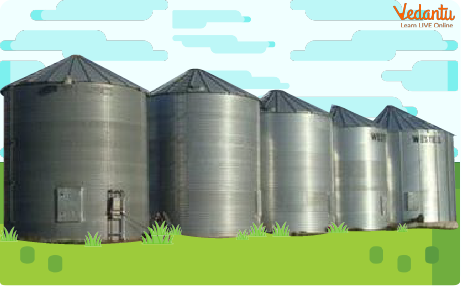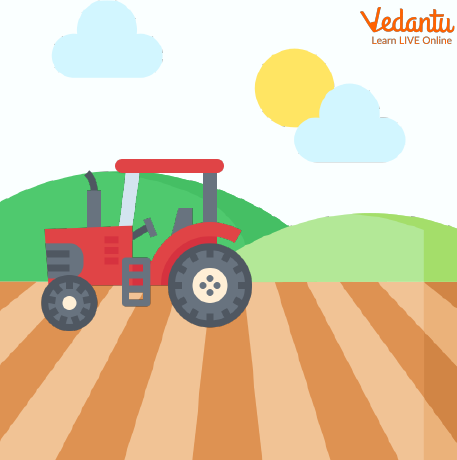




An Introduction to Grains: Grains with Names
A grain is a tiny, dry, hard, harvested seed of grasses like oats, corn, rice and wheat. Other less popular grains with names’ examples are millet, barley, rye and sorghum. Like wheat, these also have an ‘ear’ of grains on each stem. All grains are secured by a husk and inside this husk, we can find the actual seed. Some grains can be eaten whole while some have to be ground into flour (grain powder).
What do slices of bread, rotis, pasta, pastries, cakes and breakfast cereals have in common? The answer is that all of these items are made from wheat which is the most important crop or grain in the world. Wheat is so important in man’s life that it is called a staple food, it is the main food consumed daily by over 35 per cent of the world population.
Safekeeping of Grains

A Modern Storehouse for Storing Grains Safely
Special storehouses are utilised for storing grains until it is to be packed. These buildings are called granaries. A granary keeps the grains safe from hungry animals and insects. After harvesting crops, farmers stock up the granaries for storing them until they are to be sold or used.
Food Grains Names List
There are many different types of grains. The following are the most common food grain examples consumed by people all over the world.
Wheat
Oats
Rice
Corn
Amaranth
Sorghum
Farro
Teff
Rye
Freekeh
Barley
Buckwheat
Bulgur
Quinoa
Couscous
Different Types of Grains - Let’s Find Out!
Maize (Corn)
In subtropical and tropical countries, corn or maize is the main staple food for many people. It is consumed as cornmeal, as a vegetable, or is ground into flour. Corn oil is extracted from corn which is then used for salad dressings or as a cooking oil.
Corn is a type of crop which needs a lot of sunshine to grow - it is usually grown in hotter climates, but can also grow in colder regions as long as sunshine is plenty. However, the varieties of corn differ in different climates.
Maize is a major food in the hotter regions of Africa and Central, Northern, and Southern America. Maize is tended by hand or can be grown on a large scale by using machinery.
Maize is seen in all sorts of colours, it can be spotted, speckled, streaked or even striped. Tortilla chips and tacos use maize as their main ingredient!
Rice
Like wheat and corn, rice is also a staple food. Rice is consumed daily by at least 2 billion people. Ninety per cent of the world's rice production happens in Asia. Rice is a swamp plant, that is, it grows with its roots submerged under water. Its hollow stems allow the flow of oxygen to reach the roots.
Let’s have a look at how rice is grown in 4 simple steps -
Preparing the Fields
The paddy rice fields are watered, ploughed, raked and flattened.
Planting
Seeds are pre-sprouted and then moved to these paddy fields. These seeds are planted in such a way (usually in straight lines) that they have plenty of space to grow.
Harvesting
This rice is ready to be harvested in three to six months’ time. The fields are drained out and the plants are cut down, tied and then they are left to dry.
Winnowing
The whole rice is then beaten to remove the actual rice grains. These grains are then sieved, tossed and crushed in order to remove any pieces of husk that were remaining.
Technological Advancements

A Tractor in the Fields
In this modern era, even agriculture is highly mechanised. Tractors are used for preparing the fields, the seeds are sown with the help of aeroplanes and harvester machines collect the ripe plants.
Uses of Grains
Grains are naturally high in fibre, helping you feel full and satisfied — which makes it easier to maintain a healthy body weight. Whole grains are also linked to a lower risk of heart disease, diabetes, certain cancers and other health problems. Some uses of grains are as follows:
High in nutrients and fibre
Lower your risk of heart disease
Lower your risk of stroke
Reduce your risk of obesity
Lower your risk of type 2 diabetes
Support healthy digestion
Importance of Grains
Despite widespread consumption, many people remain unsure whether grains support health. Some think they are an essential component of a healthy diet, while others believe that they cause harm. The truth is, whole grains in particular are linked to numerous health benefits and are mostly considered very nutritious.
Experts have recommended eating 5 to 8 ounces of grains per day, 3 to 6 ounces of which should be whole grains. For reference, one ounce of grains is equivalent to one slice of bread or half a cup of cooked pasta or rice.
Summary
Grains are super nutritious, and the consumption of grains is associated with a lower risk of several fatal diseases. Grains contain minerals such as iron, selenium, and magnesium. They also contain dietary fiber and carbohydrates that are essential to man. A balanced diet always contains some or the other type of grain. Grain is the harvested seed of grasses such as wheat, oats, rice, and corn. Other important grains include sorghum, millet, rye, and barley. Around the globe, grains, also called cereals, are the most important staple food. Humans get an average of 48 percent of their calories, or food energy, from grains.
FAQs on What is Grain?
1. What is a grain?
A grain is the small, hard, dry seed of a plant, which is harvested for food. These plants are usually types of grasses called cereal grasses. Every grain has a protective outer layer, and inside, it contains the nutrients needed for a new plant to grow. Grains are a basic food for people all over the world and are a primary source of energy.
2. What are some common examples of food grains?
There are many types of food grains eaten around the world. Some of the most common examples include:
- Wheat (Gehu): Used to make flour for chapatis, bread, and biscuits.
- Rice (Chawal): A staple food in many parts of India and Asia.
- Maize (Makka/Corn): Eaten as corn on the cob, popcorn, or made into flour.
- Oats: Often eaten as porridge for breakfast.
- Barley (Jau): Used in soups and to make some types of flour.
- Millets (Bajra, Ragi, Jowar): Small grains that are very nutritious and grow in dry areas.
3. What are the main types of grains?
Grains can be broadly classified into two main groups based on the plants they come from:
- Cereal Grains: These are the most common type and come from plants in the grass family. Examples include wheat, rice, corn, and oats. They are a major source of energy for us.
- Pseudocereals: These are seeds from plants that are not grasses, but we use them just like cereal grains. They are often very high in protein. Examples include quinoa and buckwheat (kuttu).
4. Why are grains so important in our daily food?
Grains are a fundamental part of a balanced diet for several reasons. Firstly, they are a major source of carbohydrates, which provide our bodies with the energy needed to work, play, and study. Secondly, whole grains are rich in fibre, which helps in proper digestion. They also contain essential vitamins and minerals that help us stay healthy and strong.
5. What is the difference between whole grains and refined grains?
The main difference lies in how much of the original grain seed is left after processing.
- Whole Grains: These contain all three parts of the grain seed – the bran (outer layer), the germ (embryo), and the endosperm (food supply). Examples are brown rice, whole wheat flour (atta), and oats. They are very rich in fibre, vitamins, and minerals.
- Refined Grains: In these grains, the bran and germ have been removed during milling. This gives them a finer texture and a longer shelf life but removes much of the fibre and nutrients. Examples are white rice and all-purpose flour (maida).
6. How are grains like wheat and rice used to make different foods?
Grains are very versatile and can be transformed into many different foods. For example, wheat grains are ground into flour (atta or maida). This flour is then used to make dough for chapatis, puris, bread, cakes, and noodles. Rice grains are usually boiled or steamed and eaten with dal and vegetables. They can also be ground to make flour for dishes like idli and dosa.
7. How do farmers grow grains, and does growing the same grain damage the soil?
Farmers grow grains by first preparing the soil, planting the seeds, and then providing water and care until the plants are ready for harvest. Yes, growing the same crop in the same field year after year can damage the soil. This is because each type of plant takes specific nutrients from the soil. If the same nutrients are taken out continuously, the soil becomes weak and loses its fertility. To prevent this, farmers practice crop rotation, where they grow different types of crops in a cycle to keep the soil healthy.
8. Which grains are commonly eaten in different parts of India?
The consumption of grains varies across India, largely based on climate and tradition. In northern India, wheat is a staple, used for making chapatis and other breads. In southern and eastern India, rice is the primary grain. In the drier, western and central regions of India, millets like jowar (sorghum), bajra (pearl millet), and ragi (finger millet) are very popular as they can grow in tough conditions.









